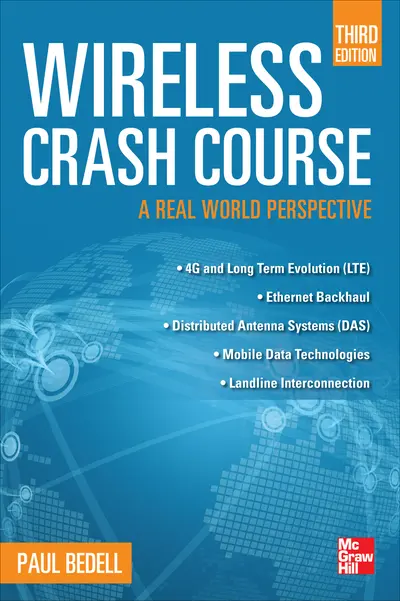My Account Details

ISBN10: 007179803X | ISBN13: 9780071798037

Step 1 . Download Adobe Digital Editions to your PC or Mac desktop/laptop.
Step 2. Register and authorize your Adobe ID (optional). To access your eBook on multiple devices, first create an Adobe ID at account.adobe.com. Then, open Adobe Digital Editions, go to the Help menu, and select "Authorize Computer" to link your Adobe ID.
Step 3. Open Your eBook. Use Adobe Digital Editions to open the file. If the eBook doesn’t open, contact customer service for assistance.
GET A SOLID GROUNDING IN CUTTING-EDGE CELLULAR TECHNOLOGY Gain an overall understanding of the constantly evolving spectrum of wireless technologies, devices, and standards. Completely revised throughout, Wireless Crash Course, Third Edition offers straightforward explanations of all aspects of cellular networks and provides clear information on cellular design and operational concepts. Learn the fundamentals of cell base stations, radio frequency (RF) technologies, microwave radio systems, and 3G and 4G / LTE technologies, and discover practical new applications and mobile data technologies. Examples, photos, and illustrations from the field are included in this practical guide. COVERAGE INCLUDES: Cellular radio history and development The cell base station Basic cellular network design and operation Radio frequency (RF) operation and technologies Antennas, RF power, and sectorization Distributed antenna systems (DAS) Base station elements and RF signal flow 2G and 3G digital wireless technologies Cellular generations overview 4G and Long Term Evolution (LTE) Microwave radio systems Cell site to MTSO network connections The MTSO, core network, and network operations center (NOC) Personal communication services (PCS) and current marketplace Towers Capacity management, propagation models, and drive testing Interconnection to the landline public switched telephone network (PSTN) Roaming and intercarrier networking Mobile data technologies The business side of wireless Mobile applications
Ch. 2. The Cell Base Station
Ch. 3. Basic Cellular Network Design and Operation
Ch. 4. Radio Frequency (RF) Technologies and Operations
Ch. 5. Antennas, Radio Frequency (RF) Power and Sectorization
Ch. 6. 2G/Digital Wireless Technologies
Ch. 7. 3G/Third Generation Wireless
Ch. 8. 4G and Long-Term Evolution (LTE) (new)
Ch. 9. Personal Communication Services (PCS)
Ch. 10: Towers
Ch. 11. Base Station Equipment and Radio Frequency (RF) Signal Flow
Ch. 12. Capacity Management, Propagation Models, and Drive Testing
Ch. 13. The MTSO, the Wireless Core Network, and the Network Operations Center (NOC)
Ch. 14. Microwave Radio Systems
Ch. 15. The Backhaul Network: Cell Site to Core Network Connections
Ch. 16. Interconnection to the Landline (Public Switched) Telephone Network
Ch. 17. Roaming and Intercarrier Networking
Ch. 18. Wireless Data Technologies
Ch. 19. The Business Side of Wireless
Ch. 20. Wireless Applications (new)
Appendix A: Wireless Industry Publications and Web Sites
Appendix B: Acronyms/Glossary
Appendix C: Test Question Answers
References
Need support? We're here to help - Get real-world support and resources every step of the way.